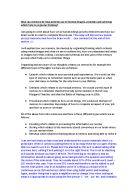There are schemata at all levels of abstraction from abstact ideologies such as justice to concrete schemata for faces. Furthermore schemata comprise the knowledge and experience we have of the world and are not abstract rules, that is, they embody a prototype rather than a defining-attribute approach.
"Schema", then, is a rather loose concept frequently used in theories about the representation of knowledge. It goes beyond the atomistic view of concepts involved in semantic networks, and sees generic knowledge as being grouped together in structured clusters of concepts, ie. schemata. Schema theories attempt to explain how stuctured representations of this kind embody and enable the use of generic knowledge.
In order to consider how the above ideas could help us to understand human longterm memory we first need to take a step back and consider the nature of longterm memory. Longterm memory is a knowledge store of apparently infinite capacity. It is heuristically useful to distingush between episodic memory and semantic memory, although in reality this may be closer to a continuum. Episodic memory refers to knowledge about the particular experiences of an individual, whereas semantic memory is concerned with general, de-contextualized knowledge. The issues of content, organisation and operating characteristics are not well understood for longterm memory. Important and unavoidable features of longterm memory are its diversity of content and its organization for stuctured yet flexible performance. The question is how well does schema theory capture these important features and elucidate still unclear issues?
I would like to investigate this question using four themes suggested by John Bowers: selection, inferencing, integration and reconstruction. These arbitrary divisions simply provide a useful framework for discusion. The themes refer to processes which presuppose a certain type of underlying organisation.
Selection appears to play an important role in comprehension and is paralleled by the idea of embedding. Instantiating a slot with a particular piece of episodic infornation will tend to preserve the memory trace for that information and make it more likely to be recalled. Chiesi, Spillach and Voss's (1979) experiment claimed that selection explains why expert subjects with more prior knowledge, ie more detailed schemata, could use this more effectively to filter out and thus recall important points. Pichert and Anderson (1977) showed that after having read a passage from a certain perspective, subjects recalled proportionally more perspective-related than unrelated information. Sachs (1967) showed that the exact surface form of texts is not retained, rather the meaning is extracted. This is the recieved view of Bartlett's work; we remember the "gist" of a story rather than its details.
Selection does not make explicit the exact nature of the relation between memory and comprehension, nor does it distinguish recognition and recall; we must be careful to distinguish between availability and accessibility. Anderson and Pichert (1978) extended their original experiment to include a perspective shift, which caused details relevant to the new perspective to be recalled. These details were not recalled under the original perspective. This suggests that selection operates at retrieval rather than at the initial time of comprehension. An interesting study by Koler and Ostry (1974) showed that subjects who had been shown sentences in different orientations performed better in recognition tests when the test sentences were presented in the original orientation. So surface forms can be remembered using the correct kind of memory test. If the conditions at retrieval are the same as at comprehension then there is a better chance of recalling the information, since the same mental operations are likely to be used. This evidence suggests that selection alone cannot capture the complex nature of memory representations.
It is argued that inferencing illustrates the crucial role of stored information in comprehension. Inferences help make better sense of situations, for example, when information does not comply with cultural expectations. Despite problems with the experiments which are cited in favour of inferencing, it is difficult to deny the fact that inferences are made. However, we still need to know what memories look like after inferencing has taken place. This point links up with the next theme to be discussed, integration.
Integration concerns the way in which new episodic information is combined with old schema-based information. In its most extreme form knowledge is automatically updated and cannot return to its original state. Evidence in favour of such a process includes people being influenced by what is suggested to them after an event, for example, eyewitnesses to accidents and crimes can be easily misled to change their recollection of an event (Loftus, Miller and Barns, 1978). If this is true then clearly it has serious implications as to the reliability of eyewitness testimony. We do not want to deny that new information can be incorporated into memory, allowing new information to be related to old, however there is evidence against a purely destructive view of integration. When new information is discredited the original memory state can still be accessed, implying that old and new memories coexist.
Reconstruction is based on the idea that memories are fragmentary and that when we remember something we use general knowledge schema to "fill in the gaps". This leads to systematic errors in memory tests; people incorrectly remember having seen schema-based items which in fact were not present at the original time of reading, ie they are reconstructing their memories. This would appear to be the reverse of inferencing at comprehension and has often been cited as how Bartlett saw remembering, however, this has been challenged. If, as claimed above, the original memories are still intact this would undermine a pure reconstuction hypothesis. So, reconstruction appears not to be the only retrieval strategy, but the one which follows the route of least resistence. The original memories appear still to be available but require more extreme retrieval conditions such as an unexpected and unusual theme change to make them accessible.
The key debate appears to revolve around the question of at which point these mental operations act on knowledge: at selection or at retrieval?
Let us now turn to review of more general problems facing schema theories. If some predicted effect of a schema fails to occur then the data can be explained away either by arguing that the subjects did not posess the relevant schema or that an inapropriate schema was used. If memory is to be explained in terms of the activation of certain schemata then independent evidence of their existance is necessary. Ways of establishing this include specifying their content or specifying how they are created and how they develop. Unfortunately it is difficult to characterize the content of schematic stuctures with any precision and they are often criticised as being unprincipled or unconstrained. A pattern of results can be accounted for by "fixing" the content of a schema. One solution may be to specify the content of the schemata, however the breadth of human knowledge makes this an impractical proposition. On the matter of how schemata change and develop most theorists have remained silent or assumed that schemata are induced or abstracted from many specific experiences. Rumelhart and Norman (1981) presented a promising desriptive framework to acount for this, however, it has not yet been tested rigoruosly.
Furthermore schemata as desribed above do not manifest the flexible behaviour we might expect of them. For example, they do not account for interdependencies among possible slot fillers; if a slot is filled with a particular value, eg wardrobe, it should initiate changes in the default values for the other slots in the schema, eg. bed.
Perhaps these shortcomings can be remedied by connectionist and similar approaches to the problem such as MINERVA II. The system retains a number of specific episodic "memories". Given a retrieval cue or "probe" schemata emerge from a weighted combination of all the memories in the system, supporting the idea of mental operations acting on schemata at retrieval. There exists no representational construct which is a schema, only patterns which produce effects attributed to schemata in previous research. This approach could solve the problem of the unprincipled nature of schema theories, as well as specifying a means by which schemata acquire their contents, ie develop.
However, there is room for a note of caution; connectionist models still need time to develop and be tested rigorously before their true worth can be judged. Also a further revolution in the field of computer science could also be accompanied by a new way of looking at schemata. So the basic schema idea could be along the right lines. However, if it is to be used to understand human longterm memory then the question of implementation is of vital importance.
Bibliography
Bartlett, F (1932) Remembering
Brewer, F. & Nakamura, G. (1984), Handbook of Social Cognition,
in Wyer, R. & Srull, T. (eds)
Hintzman, D. L. Minerva-2: A Simulation Model of Human Memory,
in Behaviour Research Methods, Instruments & Computers 16
Rumelhart, D. & Ortony, A. (1977), Schooling and the Aquisition of Knowledge,
in Anderson, R. et al. (eds)
Rumelhart, D. & Smolensky, P. Schemata & Sequential Thought Processing in PDP Models







